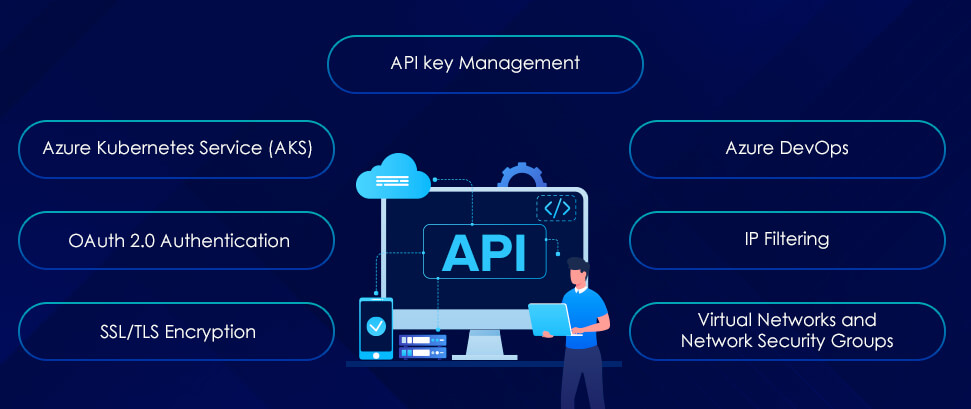- What is API Management?
- 8 Ways API Management Secure Microservices Architecture
- Using Azure API Management for Securing Microservices API
- Why Partner with Tx to Secure Your Microservices API Architecture?
- Summary
Microservices architecture is necessary for developing scalable and modernized applications in today’s interconnected digital world. Businesses are also increasingly depending on microservices architecture, making it necessary to secure each interaction. However, with the rising dependency, the challenges of managing and securing APIs are also increasing. According to statistics, unique API attacks increased by 60% from Q2 2022 to Q2 2023. APIs account for 83% of web traffic and are the prime target of cybercriminals. Now the question is, “What should businesses do to secure their microservices API?” Azure API management offers a comprehensive solution to address secure concerns and protect microservices API.
API management enhances security, streamlines operations, and improves scalability. It allows businesses to gain centralized control to monitor and manage all API interactions, ensuring every data exchange follows security protocols consistently. Let’s examine why implementing a comprehensive API management strategy is crucial to transforming microservices architecture into a scalable, secure, and efficient infrastructure.
What is API Management?

API management creates consistent and updated API gateways to support existing backend services. It allows businesses to create, disseminate, analyze, and document APIs securely and concisely. Organizations use API management to publish APIs to external and internal developers and maximize the value of their data and services. This process helps ensure that both internal and public APIs are secure and consumable. One example is the Azure API management platform, a hybrid, multi-cloud management platform for APIs across all environments. It supports the complete API lifecycle and falls under the category of platform-as-a-service.
The primary function of Azure API management is to facilitate a central interface for creating, setting up, and managing API for cloud and web applications and services. Businesses use Azure API Management to:
• Monitor APIs health
• Provide details about AI usage
• Rate limits on each API
• Identify errors
• Configure route-level throttling
8 Ways API Management Secure Microservices Architecture
API management is necessary for securing microservices architecture. It offers several key capabilities to improve security and ensure seamless communication between devices or services. Let’s take a look at some of the ways API management secures microservices:

• It allows businesses to handle authentication to verify users’ or services’ identities when trying to access microservices. The process involves using token-based systems like OAuth2, in which tokens are issued after successful authentication and used for subsequent authorization checks. Businesses can control the enforcement of authorization policies to ensure that users or services have the required permissions to perform particular actions on microservices.
• Leveraging API gateways can limit the rate at which requests are sent to microservices to prevent DoS attacks. It ensures businesses’ microservices are unaffected by too many requests, protecting the system from potential breakdown.
• API management solutions require utilizing secure communication protocols like HTTPS to encrypt data in transit between services. This ensures businesses protect their sensitive data from interception and unauthorized access as it moves across the network.
• API gateway acts as a single-entry point, providing additional security measures like SSL/TLS termination. Businesses can offload the responsibility of managing secure connections from microservices to gateways, which centralize and optimize security measures.
• API management tools monitor API traffic to detect and respond to unusual patterns indicating security threats. These threats could include repeated failed login attempts, a spike in bot traffic, or traffic from a particular source. This facilitates early detection and mitigation measures for potential security incidents.
• API management tools provide effective logging and auditing mechanics to allow businesses to track who accessed what services and when. This feature type is useful during post-incident analysis and to meet compliance requirements regarding data access and privacy.
• API management helps ensure that security updates do not disrupt service continuity by managing different API versions. It phases out all the deprecated APIs.
Using Azure API Management for Securing Microservices API
API management allows businesses to check APIs’ status, locate faults, configure throttling and set rate limits on each API. Microservices architecture helps develop scalable, modern apps but introduces security challenges due to numerous API interactions. As businesses increasingly depend on this architecture, securing APIs has become crucial. API management addresses the security requirements by offering centralized control over API interactions, enabling API management via authentication, secure communication protocols, rate limiting, etc. Azure API management further enhances this security framework by supporting the API lifecycle in a hybrid, multi-cloud environment.

To know how Tx can help you in securing your microservices architecture, contact our experts now.
Microsoft Azure offers a scalable platform for managing, handling, and securing microservices architecture by leveraging services and tools to support development, deployment, and API maintenance. Here’s how it plays a key role in securing and managing microservices.
API key Management
It offers API key capabilities to authenticate and authorize microservices API access. Businesses can generate unique API keys for each app or client and implement key-based authentication at the API gateway.
Azure Kubernetes Service (AKS)
It streamlines Kubernetes’ deploying, managing, and operations, which helps orchestrate microservices. It offers features such as automated updates, self-healing, and scaling capabilities. AKS easily integrates with Azure Active Directory to offer network policies for managing and securing traffic flow between microservices.
OAuth 2.0 Authentication
It facilitates the implementation of OAuth 2.0 authentication for robust and secure access control. Businesses can easily integrate with identity providers, such as third-party OAuth providers or Azure Active Directory.
SSL/TLS Encryption
Businesses can enable SSL/TLS encryption to encrypt data in transit and ensure protection against man-in-the-middle and eavesdropping attacks. It supports SSL termination, allowing businesses to terminate SSL/TLS connections at the gateway to offload Azure microservices overhead. This, in turn, improves the scalability and performance of microservices while maintaining secure communication channels across servers and clients.
Azure DevOps
It supports CI/CD pipelines for microservices, facilitating secure development practices and rapid deployment of security updates and patches.
IP Filtering
Businesses can use Azure API management’s IP filtering capabilities to restrict access to microservices API based on IP addresses. It can whitelist trusted IP addresses and blacklist unsecured ones to improve security.
Virtual Networks and Network Security Groups
Azure supports creating private networks in the cloud while restricting access to resources via NSGs. Azure Firewall and NSGs create a secure environment for microservices by limiting outbound and inbound traffic to resources based on security rules.
Why Partner with Tx to Secure Your Microservices API Architecture?

As one of the leading digital QA and engineering companies, Tx is key in securing your microservices API architecture. We implement rigorous testing strategies and methodologies to identify vulnerabilities and ensure compliance with security standards. Here’s how we can contribute to securing your microservices API architecture.
• We offer comprehensive security assessments, including pen testing, security audits, and vulnerability scanning. This helps identify security vulnerabilities in API endpoints and mitigate your security risks before deployment.
• API contract testing for microservices architectures to ensure all APIs fulfill the agreed-upon specifications and interact correctly with other services.
• Load and stress testing to ensure your APIs handle a higher number of requests without affecting functional integrity and performance.
• Regulatory and compliance testing to ensure your APIs comply with legal requirements like GDPR and HIPAA. This prevents legal repercussions and improves end-user trust by protecting their data.
• We integrate our testing processes into the CI/CD pipeline to ensure every API update undergoes rigorous testing before deployment.
Summary
API management allows businesses to check APIs’ status, locate faults, configure throttling and set rate limits on each API. Microservices architecture helps develop scalable, modern apps but introduces security challenges due to numerous API interactions. As businesses increasingly depend on this architecture, securing APIs has become crucial. API management addresses the security requirements by offering centralized control over API interactions, enabling API management via authentication, secure communication protocols, rate limiting, etc. Azure API management further enhances this security framework by supporting the API lifecycle in a hybrid, multi-cloud environment.
To know how Tx can help you in securing your microservices architecture, contact our experts now.
The post How Does API Management Secure Microservices Architecture? first appeared on TestingXperts.






